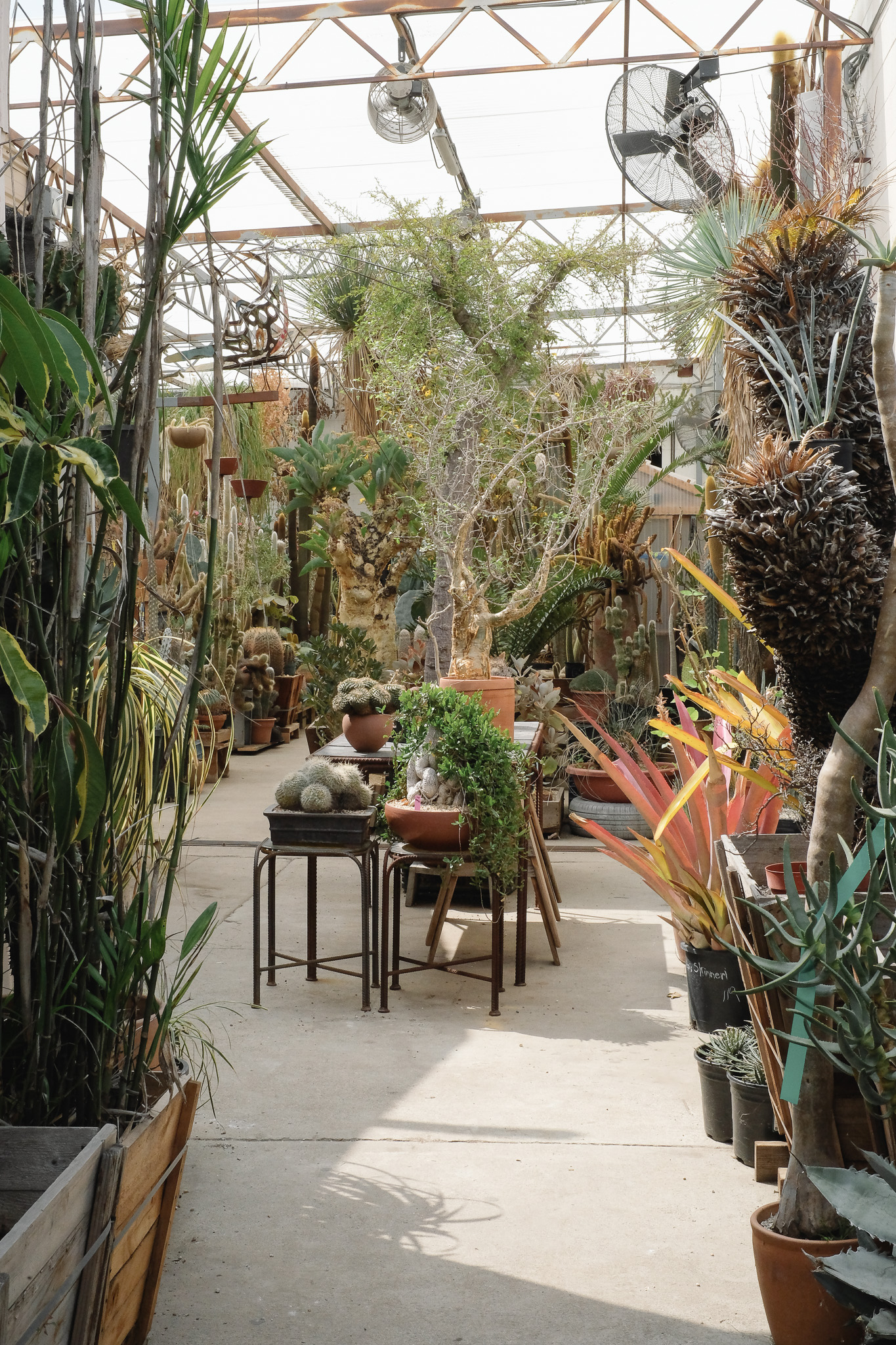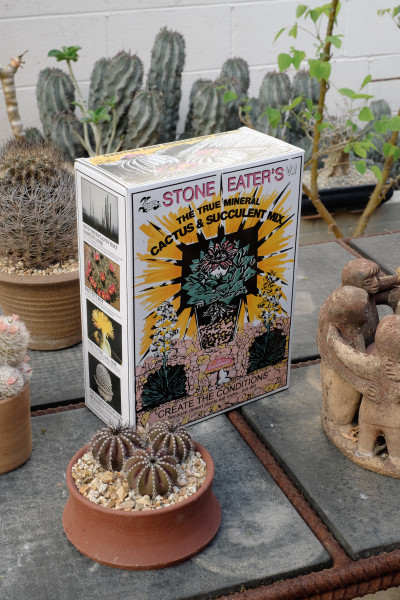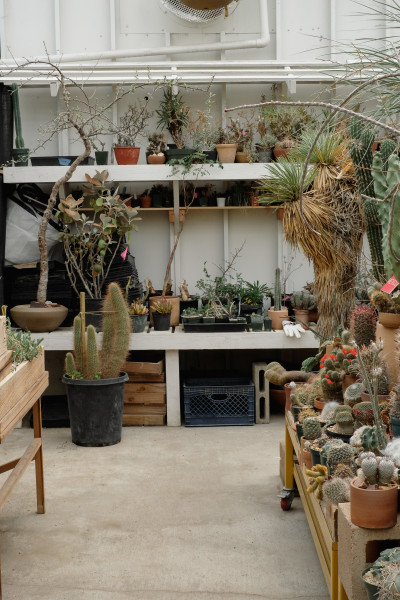Hot Cactus
A chat with Commune alumnus Carlos Morera about all things cactus.
07.8.2023

So Carlos, what is Cactus Store?
Well, it has a variety of different names. But Cactus Store is one and I guess it's a multi-disciplinary studio sort of like Commune, all based around the natural world and mostly around plant life. So, it's like a fucked-up version of the Eames studio or something, but focusing on the botanical world.
I think coming from Commune, I was always inspired and interested in a cross disciplinary approach, and I could never consider myself a graphic designer, like one thing, you know? So, we wanted to create something that had all these different outputs in different fields. That would then influence each other — that landscapes would influence T shirts and T shirts would then influence television shows which influence pop. So, it's sort of like an amalgamation. But it's always changing.
How did it start?
Well, Max (Martin) and I, and my Uncle Johnny. We saw this store on Echo Park Boulevard. The original store. I had recently left Commune and Max and I were talking about starting something. We didn't want to work with clients at all. And all of us had been collecting plants for a while and then I don't know why but for some reason, we looked at that store and were like if that thing ever goes vacant, we're going to open a cactus store there. It was just like a silly idea, and then three weeks later, we saw a for rent sign on it. We emailed the landlord who actually happened to be Beatrice Valenzuela, who was a friend of Commune and she liked the idea but we had to open in two weeks because she wanted it rented for the holiday season. And we just hauled ass and just worked like 24 hours a day and opened in time.
What was the first iteration like? What was in the shop?
It was like 200 square feet. And there were a lot of large specimens. It was an eclectic mix of stuff. I think that we were trying to avert the nursery model where it was a flat of 15 plants all the same plant, so we were hand choosing these things that were way too big to be in the store. And with the scale of the space and just presenting plants in a way that we had seen them presented in plant shows, and in the collector's world as a single specimen that presented the individuality of each plant. We hadn't seen that available to the public really.
Where were you finding the plants?
We were finding them from old nurseries or from old growers in Arizona and New Mexico and Los Angeles, but it was a different time back then. There was an older generation that had been really active in the 50s and the 60s, that were getting too old to care for their plants. And at the time there wasn’t a new generation of people yet that were interested in this world. We'd go to plant society meetings and they'd be like, okay, young ins, you can put out all the chairs, and we’d just be sitting there, eating cold hot dogs with a bunch of 85 year olds, which was cool. We were also getting all these house calls from people being like, “hey, so and so passed away and their spouse can't take care of these plants, do you guys want to purchase their collection?” We'd go and it was like Indiana Jones, the craziest. I mean it's like in the furniture world! Like if you went in and there was like the first prototype of the Eames chair in someone's garage sitting next to a used Bauhaus handkerchief, all of this crazy shit, it was like WHOA! I look back and wish we would have never sold any of it. I mean, we had to because it was a store and we had to keep the merchandise moving. We did keep some of it in our collection, there was so much of it. But the stuff that was in that store was crazy top notch, you'll never find it again, either insanely rare or just so old and like, overgrown. You just never find a plant like that anymore.
Is it all like closed adoptions? Or do you know how these specimens are doing with people?
There are a few customers we still have contact with. I don't know where the rest of them ended up. I dream about it. Where did that aloe go?
So, it keeps you up at night. I love it.
That was a cool era. Now people are flying in from China and there's like a mile long line down the street in some town in Riverside or something like that of people who have flown in to see what's in the collection.
So, backing up, you were at Commune what years? What did you do? Graphics right?
Yeah, I was there from like 2009 to 2015. In the beginning I would do everything. I would hand paint a tent and design packaging and put together presentation books. It was nice because it was very hands-on. It wasn't strictly graphic design. I also did the blog.
How big was the studio back then. What were the big projects?
Well, when I started, they had just finished the ACE Palm Springs maybe like a year before that, so that's one of the big projects that defined Commune's place in the world. I tried not to do just graphic design, or graphic design that I tried to pass off as other than “graphic design”. Which at the time was weird. I think it's more flexible nowadays.
And from Commune to here, I mean, seems like point A to point B, you had had this hobby. You had seen the shop. You're waiting for the shop to become available. What was the journey, was there anything else in between?
It seems seamless now, I guess. But back then it felt very unknown. I knew that I wanted to start my own thing, but I didn't know what it was going to be. I think I originally thought I was going to leave to start something with Jeff (Kaplon) who was also from Commune. We thought we were going start this architecture firm that was human scale built with your hands. Sort of like design-build.
I basically had told myself that I was going to be at Commune as long as it took for me to learn and be able to run my own projects and be completely autonomous. And that took a long time and there was a lot of amazing learning from Roman. And then there came a day where I was like, I can do this on my own now. But I didn't know what I was going to do. And then Max and I were like “yeah, let's start something”. But I think the premise was, “okay, we're going to start a design studio and we're going figure out how not to have any clients.”
Expand on that.
I think the idea was, we're going start a bunch of different businesses or entities. And so, the cactus store was the first one of those projects. It was like its own entity that would then funnel money back into the design studio. But it’s become tighter in its subject matter. Before we thought we were going to have a design studio, a cactus store, a laundromat…a crazy array of different things.
So then, bring us up to speed. Where are we today? What's the history of this space?
So first we opened the store. Then we got a studio space which was in Echo Park, and it was a tiny little garage, and we sort of ran the store out of there. And it was crazy. It was like we’d have our desks and stuff and then we would bring in plants from different buying trips and we would have these huge plants like, 10 foot five- or 600-pound cacti that we would then lay all throughout the studio to dry (because you have to dry the roots before you plant them or else they can get fungal infection). So, we had dehumidifiers running in the studio with our desks in the middle with all these giant plants around. Nuts!
So, we had the store and then we did a few T-shirts for the store. And then those did well, and people started asking for them. So, we started designing some more T-shirts and then clothing. And then we did a book. You know, we were like, I don't know, sort of in our travels we met all these people who had all these crazy collections of old habitat photos. We were like we should do a book. And then one of our customers from the store who became our friend was like, “I just bought a house, would you guys ever consider landscaping it.” And Johnny was an ex-landscaper, so we started the landscape portion. And then someone asked us to do a greenhouse and we did a greenhouse with Jeff and then I don't know it sort of just started to snowball. We started doing lectures and then we were like “we could do a TV show”, so we started working on a pilot with A24 for a new nature show. Everything spilled out one thing and would start the next. So yeah, it's been exciting. Be careful what you wish for!
There was a moment, I remember, maybe six months ago, where I was in the studio and there were two editing bays on which they were working on the television show. And then, Marina and Nina were drafting landscape plans. We had just had a bunch of new prints come in from the silk screener with the T shirts. I had another meeting with Jeff about a big greenhouse project we're doing in Ojai. And I was like, THIS IS IT! But it was also terrifying and so overwhelming and psychotic to try to jump between those 10 things in a single day. I'm still trying to figure out how to manage the dream. Like…it's not that fun!
What's next? What can you say about the TV show? And what other projects are in progress?
Well, yeah, the TV show…they're shopping it around.
Will it be travel-style?
It’s sort of travel? Yeah, in a way. It's way more bootleg than you'd expect. Somewhere between a fucked-up Power Point presentation and a family home movie. And shit found on the internet that we scrambled together. It's homemade. We’ve also been working on a scripted show, but we haven't gone to pitch that yet. We're working on this project with Jeff trying to make a children's book. And non-human teachers which is our nonprofit that we just started. We also have an event series in New York, running through the summer, that's basically pairing scientists or people coming from the study of the natural world mixed with artists and musicians. We're working on a big project on Western that's a parking lot that we're turning into a greenhouse. So, it's gonna be a parking lot inside of a greenhouse.
LA needs that.
We’re also working on vinyl records. We were like, “you know what? we should do records why haven't we done that?” Like putting out recordings of bird sounds.
Love that. I was talking to another collaborator of ours Chris Cole Meyer. He's a musician and plays in an orchestra. Trumpeter and then he did sound installations for Bon Iver and The National. But he's telling me he got his first commission as sort of like a landscape designer, basically designing for a blind client. So, he's doing all this research into atmospheres and environments that would attract specific birds so that the client can walk outside and audibly experience his garden. I thought that was like a beautiful and interesting approach.
Similarly, we’ve been collaborating with David Wiseman on his garden that we turned into a bird sanctuary. He's making different sculptures for birds to nest, and we’ve planted a bunch of native and non-native plants that attract birds. And we worked with bird consultants on that.
The BC on the project?
Ha-ha…yeah…!
We are also working on some terracotta pots with you guys. We're trying to develop like fucked up garden gnomes and like weird dogs and heads for people’s gardens. We’re working on a project right now for Knoll and Herman Miller, which is a research project into reimagining plants in the office space and interiors. Yeah. It’s like a year-long research project that we just completed, that may or may not end up in a product, but we're going into the second phase right now of developing some physical solutions to the issue. So that was sort of like a dream project that happened. Yeah. The TV shows I think we really want to make happen. Yeah. So, if we could have like a show on plants on HBO that would be the dream.
And lastly, she walked in a second ago, but your wife Sofia, tell us about how it’s like working together. You guys work on so many different things. Seemingly so fluid, including maybe your greatest collaboration to date? Young human beings.
On our first date Sofia came with me on a cactus dig in San Diego. One of the first pictures I have of her is of her helping me load plants into the back of a trailer. Then I think I helped her build a bunch of racks in her old studio because she was making as usual, crazy-huge, concrete works that were insanely heavy and insanely big. And so, our whole relationship has been that, us helping each other back and forth in this collaborative way. She's always been an amazing ceramicist. For El Centro she made a few murals, which was her first foray into that. We then started including her work in a lot of our projects which was a perfect fit. And then yeah, we have a new daughter which is crazy. So now we collaborate 24/7. But it's fine, Sofia's studio is more or less at the house now. And after dinner, it's sort of great, we just like to go outside and she works on glazes and I help with stuff and it's just a really, tranquil, beautiful time.
Photos by Dante Iñiguez
































